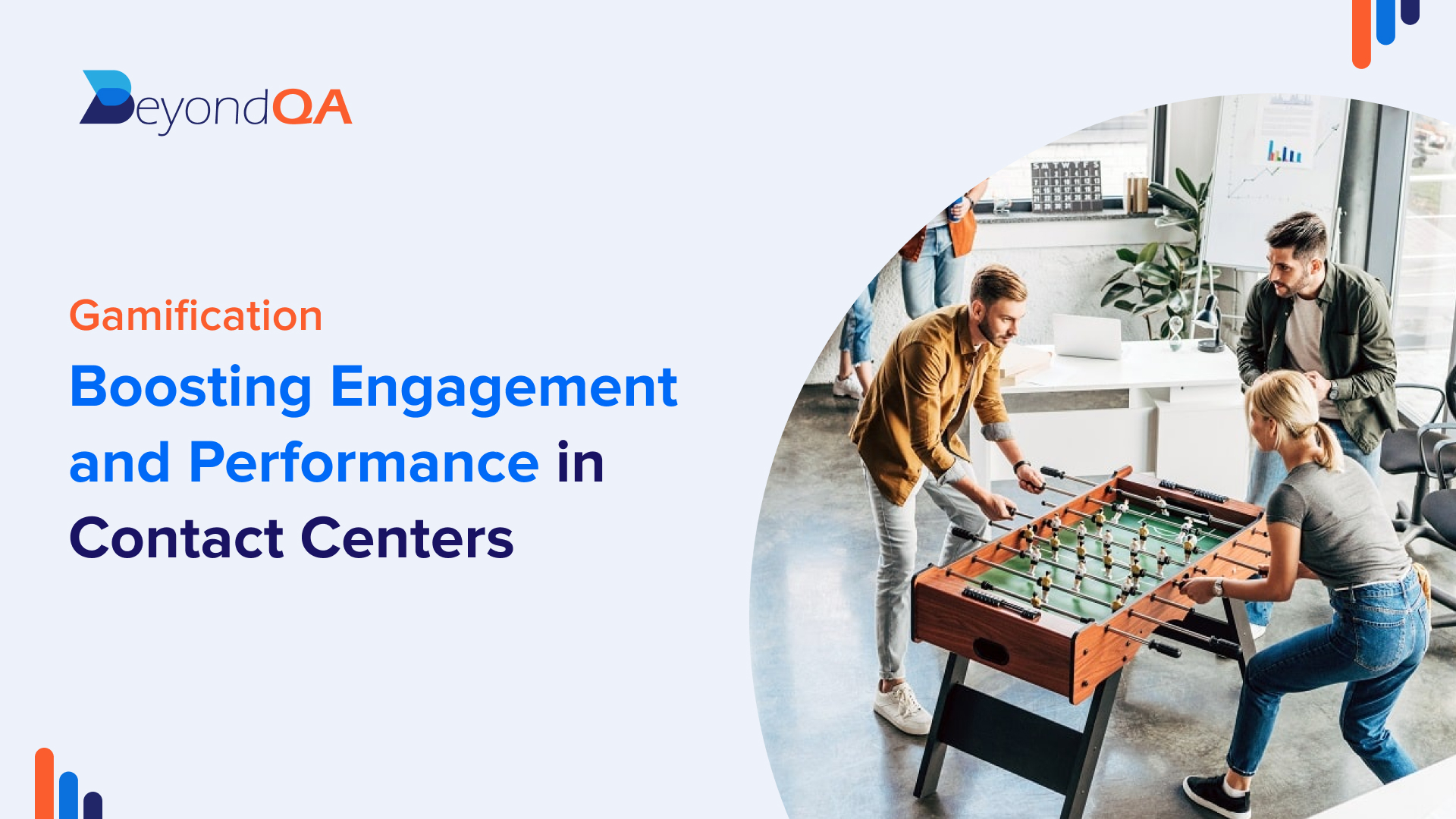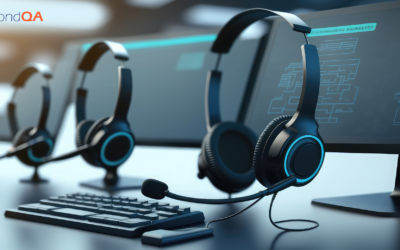Introduction
Gamification is the integration of game elements and mechanics into non-game contexts, such as business processes or customer interactions, to engage and motivate individuals to achieve specific goals. In the context of contact center quality management, gamification involves using game-like features, such as points, badges, leaderboards, and rewards, to create a more dynamic and enjoyable work environment for agents.
Importance of Contact Center Gamification
In the high-pressure environment of contact centers, agent engagement and performance are critical factors that directly impact customer satisfaction and overall business success. Engaged agents are more likely to provide exceptional customer service, exhibit higher levels of productivity, and stay committed to their roles. On the other hand, disengaged agents can lead to decreased service quality, lower job satisfaction, and higher agent turnover rates.
Contact centers can effectively boost agent engagement and performance by implementing gamification strategies. Gamification fosters healthy competition, encourages skill development, and promotes agent teamwork. It taps into agents’ intrinsic motivation, making their daily tasks more enjoyable and rewarding. Ultimately, contact center gamification not only enhances agent performance but also improves the overall customer experience, making it a valuable tool for contact center optimization.
Understanding Gamification in Contact Centers
Contact center gamification is the application of game-like elements and mechanics in non-game contexts to motivate individuals and encourage specific behaviors. In contact centers, gamification incorporates elements such as points, badges, leaderboards, challenges, and rewards to transform daily tasks and interactions into engaging and rewarding experiences for agents.
The concept of gamification relies on the principles of intrinsic and extrinsic motivation. Intrinsic motivation stems from the inherent enjoyment and satisfaction an individual derives from completing a task or achieving a goal. By adding elements of fun, competition, and achievement through gamification, agents become more motivated to excel in their roles. Extrinsic motivation, on the other hand, involves tangible rewards and recognition, such as earning points or badges, which further incentivize agents to perform at their best.
Key Elements of Gamification in Contact Centers
1. Points, Badges, and Leaderboards: Points are awarded to agents for accomplishing specific tasks or meeting predefined targets. Accumulating points leads to leveling up or earning badges, signifying achievements and milestones. Leaderboards display agents’ rankings based on their performance, fostering healthy competition and driving continuous improvement.
2. Challenges and Goals: Gamification sets clear challenges and goals for agents to strive towards. These challenges can be daily, weekly, or monthly targets, encouraging agents to consistently deliver exceptional customer service and meet performance metrics.
3. Rewards and Incentives: Beyond recognition through badges and leaderboards, gamification offers tangible rewards and incentives for agents who excel. These rewards can include monetary bonuses, gift cards, extra time off, or other valuable perks, providing agents with meaningful motivation to perform at their best.
Incorporating these key elements into contact center operations transforms the work environment into a dynamic and engaging space. Agents are more likely to embrace their roles with enthusiasm, resulting in heightened productivity, improved service quality, and enhanced overall performance. As a result, contact centers can harness the power of gamification to optimize agent engagement and drive customer satisfaction to new heights.
The Impact of Gamification on Contact Center Engagement
Motivating Agents through Gamified Systems:
Implementing gamified systems in contact centers has a profound impact on agent motivation. By infusing elements of fun, challenge, and competition into daily tasks, gamification transforms mundane activities into exciting opportunities for growth and achievement. Agents are more likely to feel motivated and driven to perform at their best when they can see their progress through points, badges, and leaderboard rankings.
Gamification creates a sense of purpose and accomplishment for agents. As they earn points and badges for completing tasks or meeting goals, they experience a sense of fulfillment and recognition. This intrinsic motivation fuels their enthusiasm and commitment to excel, resulting in improved performance and a positive work culture, thus improving contact center quality management.
Furthermore, the real-time feedback provided by gamified systems offers agents continuous visibility into their performance. This immediate feedback loop allows agents to gauge their progress, identify areas for improvement, and take proactive steps to enhance their skills and effectiveness.
Enhancing Agent Job Satisfaction and Retention:
Job satisfaction and employee retention are critical factors for contact centers. High turnover rates can lead to increased recruitment and training costs, as well as a loss of expertise and continuity in customer service. Gamification plays a crucial role in addressing these challenges by fostering a more satisfying and rewarding work environment.
Gamified systems create a sense of achievement and accomplishment for agents, making their work experience more enjoyable and fulfilling. Feeling valued and recognized for their efforts enhances job satisfaction and helps build a positive emotional connection with their roles.
Moreover, gamification nurtures a spirit of healthy competition and camaraderie among agents. As they compete for leaderboard positions or collaborate in team challenges, agents build stronger bonds with their colleagues and experience a sense of belonging within the contact center community.
The increased job satisfaction resulting from gamification contributes to higher agent retention rates. Agents who feel engaged and motivated are more likely to stay committed to their roles, reducing turnover and providing contact centers with a stable and experienced workforce.
Gamification for Performance Improvement in Contact Centers
Boosting Agent Productivity and Efficiency:
One of the key objectives of gamification in contact centers is to boost agent productivity and efficiency. By incorporating game-like elements and incentives, gamification motivates agents to be more focused and goal-oriented in their tasks. The competitive nature of gamified systems encourages agents to complete tasks promptly and efficiently, driving productivity levels upward.
Gamification introduces a sense of urgency and excitement to daily activities, prompting agents to complete tasks in a timely manner to earn points or rewards. This heightened sense of engagement leads to faster response times, reduced idle time, and improved overall efficiency in handling customer interactions.
Moreover, gamification creates a continuous feedback loop for agents. As they receive real-time updates on their performance, agents can identify areas of improvement and adjust their strategies accordingly. This instant feedback fosters a culture of constant improvement, where agents are motivated to refine their skills and workflows continually.
Improving Quality and Performance Metrics:
Gamification not only impacts agent productivity but also drives improvements in quality and performance metrics. With gamified challenges and goals aligned with contact center objectives, agents are incentivized to focus on delivering high-quality service to customers.
Agents strive to achieve specific targets, such as resolving customer issues within a certain timeframe or maintaining a high level of customer satisfaction. These goals encourage agents to provide more attentive and accurate support, leading to an overall improvement in service quality.
Furthermore, gamification can be tailored to align with specific performance metrics, such as first-call resolution rates or average handling times. Agents who consistently meet or exceed these metrics can earn rewards or recognition, reinforcing positive behavior and encouraging a continuous commitment to excellence.
By gamifying quality assurance processes, contact centers can also monitor and assess agent performance more effectively. Managers can track agents’ progress, identify areas where additional training may be needed, and recognize outstanding performance through gamified achievements.
Implementing Gamification in Contact Centers
Setting Clear Objectives and Goals:
Before implementing gamification in a contact center, it is essential to define clear objectives and goals. The purpose of gamification should align with the contact center’s overall strategy and business objectives. Identifying specific key performance indicators (KPIs) that the gamified system will address helps in measuring the success of the initiative.
Common objectives for gamification in contact centers include improving agent productivity, enhancing service quality, increasing customer satisfaction scores, and reducing agent attrition rates. By setting clear and measurable goals, contact centers can track progress and determine the effectiveness of gamification in achieving the desired outcomes.
Designing Engaging and Relevant Gamified Systems:
The success of gamification in contact centers depends on designing engaging and relevant gamified systems. The gamification elements should be aligned with agents’ daily tasks and their impact on customer service.
Points, badges, and leaderboards should be designed to reward actions that contribute to the contact center’s objectives and positively impact the customer experience. Challenges and goals should be challenging yet attainable, encouraging agents to strive for continuous improvement.
Training and Onboarding Agents for Gamified Workflows:
Proper training and onboarding are crucial for successful gamification implementation in contact centers. Agents need to understand the gamified workflows, rules, and objectives clearly. Providing comprehensive training sessions ensures that agents are aware of how to participate in the gamified system and how their performance will be measured.
Gamification should be presented as a tool to support agents in their roles rather than an additional burden. Demonstrating how gamification can make daily tasks more enjoyable and rewarding can help overcome any initial resistance to the new system.
Measuring and Analyzing the Impact of Gamification
Identifying Key Performance Indicators (KPIs):
To assess the effectiveness of gamification in contact centers, it is essential to identify key performance indicators (KPIs) that align with the objectives set during the implementation phase. These KPIs serve as benchmarks to measure the impact of gamified systems on agent performance and overall customer service.
• Agent Productivity: Measure the productivity of agents by tracking metrics such as average handling time, call resolution time, and the number of interactions handled per hour. Gamification should ideally lead to improved agent productivity, resulting in higher efficiency and quicker customer service.
• Service Quality: Monitor service quality metrics, including customer satisfaction scores (CSAT) and first-call resolution rates. Gamification should drive agents to provide better-quality service, resulting in increased customer satisfaction and higher resolution rates.
• Agent Retention: Keep track of agent attrition rates and job satisfaction levels. A successful gamification strategy can positively impact agent retention by increasing job satisfaction and engagement.
• Customer Retention: Analyze customer retention rates and repeat business from satisfied customers. Gamification can lead to more positive customer interactions, fostering loyalty and repeat business.
Tracking Agent Performance and Engagement Metrics:
To gain insights into the impact of gamification on agent performance and engagement, contact centers need to track relevant metrics regularly.
• Gamification Engagement: Monitor the level of agent participation and engagement with the gamified system. Keep track of how many agents actively participate in challenges, earn points, and aim for badges and rewards.
• Leaderboard Performance: Assess agent rankings on leaderboards. High-performing agents may experience an additional boost in motivation when they see their names at the top of leaderboards, driving friendly competition and encouraging others to strive for improvement.
• Achievement Unlocks: Track the achievement of badges, rewards, and other milestones. Celebrating agents’ accomplishments and recognizing their efforts can further enhance their motivation and job satisfaction.
• Feedback and Surveys: Gather feedback from agents through surveys or regular feedback sessions. This provides valuable insights into how agents perceive the gamified system and its impact on their performance and job satisfaction.
The Future of Gamification in Contact Centers
Advancements in Gamification Technology:
As contact centers continue to recognize the potential of gamification in driving agent engagement and performance, advancements in gamification technology are on the horizon. The future holds exciting possibilities for even more sophisticated and dynamic gamified systems.
• Virtual Reality (VR) Gamification: VR technology can offer immersive and interactive gamification experiences for agents. Through VR simulations, agents can practice handling challenging customer scenarios, leading to improved problem-solving skills and heightened confidence in real-life interactions.
• Augmented Reality (AR) Elements: AR can be integrated into gamified workflows, overlaying interactive elements on agents’ workspaces. Agents may receive real-time coaching and prompts during customer interactions, enhancing their performance and ensuring consistent service quality.
• Gamification Personalization: Advancements in data analytics and AI will allow for more personalized gamification experiences. Agents can receive tailored challenges and rewards based on their individual strengths and areas for improvement, further motivating them to excel.
Integration of AI and Gamification for Enhanced Performance:
The integration of AI and gamification holds tremendous potential to revolutionize contact center operations and elevate agent performance to new heights.
• AI-Powered Performance Insights: AI can analyze vast amounts of data to provide agents with real-time insights into their performance. By identifying patterns and trends, AI-powered systems can offer personalized feedback and recommendations, empowering agents to continuously improve.
• Predictive Analytics for Gamification: AI-driven predictive analytics can anticipate agent performance trends and customer demands, enabling contact centers to proactively set relevant and timely gamification challenges. This ensures that agents are prepared to handle customer needs efficiently.
• AI-Powered Coaching and Support: AI chatbots can act as virtual coaches, providing on-the-spot guidance to agents during interactions. With access to AI-driven knowledge bases, agents can offer accurate information and solutions to customers promptly.
Final Thoughts
As the customer service landscape continues to evolve, gamification holds immense potential to shape the future of contact centers. Advancements in gamification technology, such as VR and AI integration, promise even more engaging and personalized experiences for agents. The seamless integration of AI and gamification will not only drive agent performance but also pave the way for more sophisticated and customer-centric interactions.
Contact centers that embrace gamification with a focus on agent engagement, skill development, and customer satisfaction will be well-positioned to thrive in the competitive market. Gamification represents a forward-looking approach to optimize contact center operations and deliver exceptional customer service, making it an indispensable tool for the future of customer service.
FAQs
Q1: What is gamification, and how does it benefit contact centers?
Gamification is the integration of game-like elements, such as points, badges, and rewards, into non-game contexts like contact centers. It enhances agent engagement, motivation, and performance, leading to improved productivity, better service quality, and increased customer satisfaction.
Q2: Will gamification strategies work for all types of contact centers?
Yes, gamification strategies can be adapted to suit various types of contact centers, regardless of their size or industry. Whether it’s a customer support center, sales team, or technical helpdesk, gamification can be customized to align with specific objectives and drive positive outcomes.
Q3: How can contact centers implement gamification effectively?
To implement gamification successfully, contact centers should start by setting clear objectives and identifying relevant key performance indicators (KPIs). Designing engaging gamified systems aligned with agents’ tasks and providing comprehensive training and support are essential. Contact centers can partner with experts like beyondQA to ensure a seamless and impactful gamification implementation.







